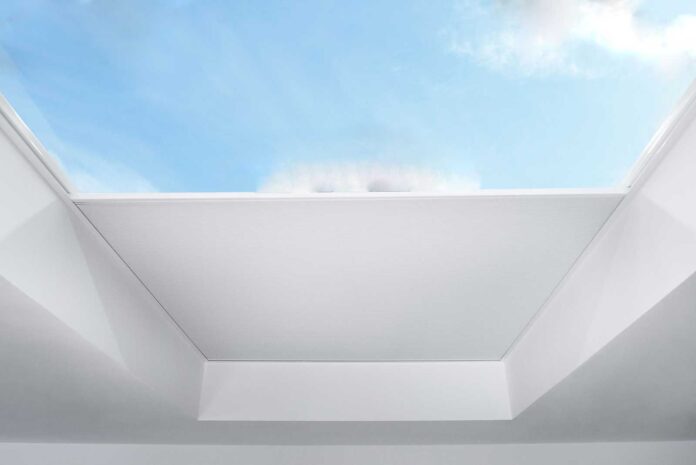Enhancing energy efficiency in our homes is crucial for reducing environmental impact and cutting down on energy expenses. By integrating solutions like skylight blinds, we, as homeowners, can create sustainable, eco-friendly living spaces. Not only do skylight blinds help improve energy efficiency, but they also contribute to lower utility bills, making them a win-win for any home.
In this article, we will explore an innovative solution for maximizing energy efficiency: electric skylight blinds. These blinds offer a dynamic way to control heat gain, reduce reliance on artificial lighting, and optimize thermal insulation. Let’s delve into the world of electric skylight blinds and discover how they can contribute to a greener and more cost-effective home environment.
Understanding Skylights and their Role in Energy Efficiency
Skylights, and the windows of our ceilings, hold a unique position in our homes and buildings. They offer a range of benefits while also presenting a set of challenges when it comes to energy efficiency.
How skylights work and their benefits
Skylights are designed to provide natural daylight into homes or buildings, serving as a source of both light and heat. Positioned on the roof, they are particularly effective at allowing sunlight to penetrate areas of the house that windows may not reach, reducing the need for artificial lighting during daylight hours. This not only helps to conserve energy but also creates a more pleasant and natural indoor environment. Additionally, skylights can provide ventilation, helping to regulate indoor air quality and temperature. The integration of these elements contributes to the aesthetic appeal of the living or working spaces, making them feel larger and more inviting.
How skylights can impact energy efficiency
When it comes to energy efficiency, skylights can play a dual role. On the one hand, the natural light they provide can significantly reduce reliance on electric lighting, leading to considerable energy savings. In addition, well-placed skylights can assist in ‘passive solar heating,’ harnessing the warmth of the sun in colder months to naturally heat your home.
However, skylights also have the potential to negatively impact energy efficiency. They can create what is known as the ‘greenhouse effect’ within a building. During the summer months, an unshaded skylight can allow excessive solar heat gain, leading to higher costs for air conditioning and cooling. Similarly, during the winter months, they can contribute to heat loss if not properly insulated, resulting in increased heating costs.
Introduction to Electric Skylight Blinds
In the realm of modern smart home technology, electric skylight blinds stand out as an effective solution for maximizing the benefits of skylights while addressing their energy efficiency challenges.
What electric skylight blinds are
Electric skylight blinds, also known as motorized skylight blinds or shades, are technologically enhanced window coverings specifically designed for skylights. Unlike traditional manual blinds, these devices can be controlled remotely, usually through a remote control, smartphone app, or integrated home automation system. This means you can adjust them without the need for ladders or specialized tools, a feature that becomes particularly useful for hard-to-reach skylights.
How they work – the technology behind them
The secret to the functionality of electric skylight blinds lies in their motorized operating systems. They employ small, quiet electric motors that are either battery-operated or wired directly into the home’s electrical system. These motors power the opening and closing of the blinds, allowing you to adjust the amount of sunlight entering your space with the simple press of a button or even based on pre-set schedules.
Most electric skylight blinds are designed to work with a range of controls, from dedicated remote controls to smart home systems that allow operation from a smartphone, tablet, or through voice commands with devices like Amazon’s Alexa or Google Home. More advanced models offer features like solar charging for battery-operated blinds or sensors for automatic adjustment based on sunlight or temperature levels.
Key benefits of electric skylight blinds
The benefits of electric skylight blinds are manifold. Firstly, they offer convenience. The ability to adjust the blinds remotely or automatically helps to manage the lighting and temperature in your home or office more efficiently.
Secondly, these blinds play a significant role in improving energy efficiency. By controlling the amount of sunlight entering through the skylight, they can help regulate the indoor temperature, reducing the need for artificial lighting, heating, or cooling. This means you can leverage the benefits of your skylight without the energy efficiency drawbacks, resulting in potential savings on your energy bills.
Additionally, they can contribute to a better living or working environment. By providing precise control over daylight, they can help prevent glare on screens or unwanted light during specific times of the day.
Lastly, the integration of electric skylight blinds with existing smart home systems can elevate your home’s intelligence level, making it a more connected, comfortable, and energy-efficient space.
In the following sections, we will dive deeper into how you can utilize electric skylight blinds to enhance energy efficiency and what factors to consider when choosing the right solution for your needs.
The Role of Electric Skylight Blinds in Maximizing Energy Efficiency
Electric skylight blinds play a vital role in maximizing the energy efficiency of a home or building. Their function goes beyond just light control—they offer benefits in temperature regulation and can be integrated with smart home systems for optimized energy use.
Controlling sunlight penetration: Reflecting summer sun and harnessing winter sun
The primary function of electric skylight blinds is controlling sunlight penetration, and this has direct implications for energy efficiency.
During summer’s hottest parts of the day, you can close electric skylight blinds to reflect the sun’s heat and prevent excessive solar heat gain.. This helps maintain a cooler indoor temperature and reduces the need for air conditioning or other cooling systems, resulting in energy savings.
On the other hand, during winter, you can open the blinds to let in more sunlight, utilizing the heat from the winter sun to naturally warm your space. This process, known as passive solar heating, can significantly reduce the need for artificial heating, providing another avenue for energy conservation.
Insulation benefits: Reducing heat loss in winter and heat gain in summer
Aside from controlling sunlight, electric skylight blinds also provide insulation benefits. When closed, these blinds add an extra layer of insulation to your skylight, which can help reduce heat loss in winter and heat gain in summer.
In the winter months, heat tends to rise and can escape through poorly insulated skylights. Closing electric skylight blinds, especially those with insulating properties, can help trap this heat inside, reducing the amount of artificial heating needed to keep your space warm.
During the summer, the reverse is true. The blinds can help to prevent heat from the sun from entering and warming your home, thereby reducing the need for energy-intensive air conditioning.
Integration with smart home systems for optimized energy use
You can integrate electric skylight blinds with smart home systems, paving the way for an entirely new level of energy efficiency optimization. By connecting the blinds to a home automation system, you can set schedules for them to open and close at optimal times, depending on the season and your daily routines.
Moreover, some advanced systems allow for automatic adjustments based on real-time conditions. For instance, if a sensor detects high levels of sunlight, the blinds can close automatically to prevent overheating. Or if the indoor temperature drops below a certain level, the blinds can open to let in more sunlight and heat.
These smart home integrations optimize the use of your blinds, ensuring you’re maximising the benefits of your skylight and natural resources. This leads to a more energy-efficient and comfortable home or building.
How to Choose the Right Electric Skylight Blinds
No matter the style of your skylight, there are tailored solutions available. Blinds for flat roof skylights, for example, are specially designed to fit within this unique structure, enhancing both aesthetics and efficiency. For a more traditional home design, blinds for pitched roof skylights offer the perfect fit and functionality, allowing for optimal control over light and heat. Meanwhile, blinds for opening skylights are designed to maintain your ability to ventilate your space while still offering the benefits of light control, the Magic of Electric Opening Skylights. These options ensure that every skylight style has a compatible solution in the market.
Factors to consider: Size of the skylight, orientation, local climate, home design
Before selecting electric skylight blinds, consider the following factors:
Size of skylight: The size of your skylight will play a significant role in determining suitable electric blinds. Ensure you accurately measure the length, width, and depth of your skylight to ensure a good fit.
Orientation: The direction your skylight faces can influence the type of blind you choose. If it gets a lot of sun, consider blinds with reflective properties to minimize heat gain.
Local climate: Your local climate should also inform your decision. If you live in a particularly hot or cold area, look for blinds with insulating properties. If your area experiences strong sunlight, consider blinds that provide high levels of light blockage.
Home design: The style and design of your home matter too. Electric skylight blinds come in a variety of colours, patterns, and materials, so choose one that complements your interior design.
Consideration of professional installation vs. DIY
When it comes to installation, you have two main options: professional installation or do-it-yourself (DIY).
If you opt for professional installation, they can properly fit your blinds and integrate them with your smart home systems. This is especially useful for large or hard-to-reach skylights. However, this can add to the overall cost.
DIY installation can save on costs, and many electric skylight blinds come with comprehensive installation instructions. For all scenarios, particularly those that require wiring or complex integration with home automation systems, DIY might not be suitable.
Choosing the right electric skylight blinds is a crucial step in maximizing energy efficiency in your home or office. Remember to consider your specific needs and circumstances and take the time to research various brands and models before making your decision.
In conclusion
In today’s world, where sustainable living and energy efficiency are more important than ever, electric skylight blinds serve as a powerful tool to enhance the livability and environmental friendliness of our homes and workplaces.
Electric skylight blinds offer a plethora of benefits, the key among them being their contribution to energy efficiency. By providing precise control over sunlight penetration, they enable us to harness the power of the sun for natural lighting and passive heating, while also preventing excessive heat gain in the warmer months. Coupled with their insulating properties, they can help regulate indoor temperatures, reducing reliance on artificial heating and cooling.
Are you ready to make a change for the better? Take the first step towards a more energy-efficient home today and explore the world of electric skylight blinds.













